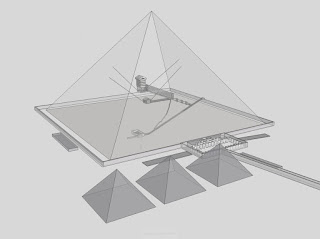Roman Amphitheatre of Uthina The Roman Amphitheatre of Uthina is located in Uthina , near Tunis, Tunisia . Building for Uthina began in 40 BC and continued through to 135 AD. The amphitheatre may have been a later addition to what was already a large town. Also located there were a fortress, cisterns, an aqueduct, a triumphal arch, a theatre, and a basilica with a circular crypt . Coordinates 36.608598,10.169214 Description The amphitheatre, partly buried, measures 113 by 90 meters. The arena measures 58 by 35 metres, giving surface areas of 7988 and 1539 square metres respectively. There are four entrances, two main entrances at each end, with the seating area supported by three tiers of columns and arches. (Although these are no longer there, measurements and amphitheater descriptions rely on a complete building.) Measurements for the amphitheatre on site are 12 0 by 89 metres, with the arena measuring 67 by 36 metres. The surface areas measure 10680 an d 24...
Queen's Chamber
Queen's Chamber Khufu's pyramid is below the King's chamber and is of a similar size and shape but with the difference that it includes a niche.
The chamber is constructed of smaller blocks with the walls made up of six blocks high, and the niche is formed from a gap of these six block layers.
The gap starts at three cubits wide and reduces to one cubit with an angle of 12°.
It has been stated that Khufu's chamber sarcophagus which measures 0.987m high, 1.051m wide and 2.276m long and with a volume of 16.5 cubits³ or 2.36m³ is connected by volume to a circle, 2 cubits and the golden ratio but what is the Queen's Chamber connected to?
Measurements
Width 10 cubits=5.23m
Length 11 cubits=5.756
Height 8.95 cubits=4.68m
Total height 11.816 cubits=6.18m
Entrance height/width
1.72m/1.046m
Niche (various)
1.27m-0.523m
Volume
140.88m³
984.92 cubits³
4975.35 ft³
Total height
6.18m ÷10= reciprocal of the golden ratio
Door ratio cubits/m
2 by 3.28
(1.72÷1.046)=1.644 (0.03 off φ)
Possible interpretations
Possible interpretations are (all in cubits)
width × length × niche slope=1320 cubit³
or
width × length × height=1300 cubit³
10×11×12=1320
10×11×11.816
1320-1300=20
In m³
186.042÷17.74=10.49
10.49−10.46=0.02715m³
Sphere for 0.02715m³ = 0.1855m
So the volume is 10.46φ + 0.1855 cubits
This can be considered as 10.46 spheres of radius φ plus a smaller 0.1855 radius sphere of ratio (1.046÷(1+φ)).
Total/Actual volume in m³
140.886+45.156
140.886+22.578
In cubits
√1300=36.052
√1143=33.805
King's chamber
√2042=45.189
Queen's chamber
Ceiling (√2042+0.03)÷2
Room ³√(2042÷984)
Here it shows that the room is considered as a height of 6.18m with the two proportions deduced as ratios of Khufu's chamber.
The ceiling of the Queen's chamber in m³ is proportional with Khufu's chamber in the ratio √volume plus 0.03, both rooms are proportional to the cubed root of their ratios ³√King/Queen, the ratio is √φ.
The factor of 0.03 could be the entrance ratio error off φ, or with this just being a building limitation. Multiplying the two numbers then a number 1.8 is achieved and connects with the volume of the sphere as 0.1855m extra.
The 0.1855m radius is very similar to the volume in cubits of 0.02715m³ which equals 0.185 cubits³.
(0.1855° is also a number for obliquity from maximum tilt to mid point obliquity, max tilt was in 1985, and mid point is 1584 years later)
Queen's Chamber Khufu's pyramid is below the King's chamber and is of a similar size and shape but with the difference that it includes a niche.
The chamber is constructed of smaller blocks with the walls made up of six blocks high, and the niche is formed from a gap of these six block layers.
The gap starts at three cubits wide and reduces to one cubit with an angle of 12°.
It has been stated that Khufu's chamber sarcophagus which measures 0.987m high, 1.051m wide and 2.276m long and with a volume of 16.5 cubits³ or 2.36m³ is connected by volume to a circle, 2 cubits and the golden ratio but what is the Queen's Chamber connected to?
Measurements
Width 10 cubits=5.23m
Length 11 cubits=5.756
Height 8.95 cubits=4.68m
Total height 11.816 cubits=6.18m
Entrance height/width
1.72m/1.046m
Niche (various)
1.27m-0.523m
Volume
140.88m³
984.92 cubits³
4975.35 ft³
Total height
6.18m ÷10= reciprocal of the golden ratio
Door ratio cubits/m
2 by 3.28
(1.72÷1.046)=1.644 (0.03 off φ)
Possible interpretations
Possible interpretations are (all in cubits)
width × length × niche slope=1320 cubit³
or
width × length × height=1300 cubit³
10×11×12=1320
10×11×11.816
1320-1300=20
In m³
186.042÷17.74=10.49
10.49−10.46=0.02715m³
Sphere for 0.02715m³ = 0.1855m
So the volume is 10.46φ + 0.1855 cubits
This can be considered as 10.46 spheres of radius φ plus a smaller 0.1855 radius sphere of ratio (1.046÷(1+φ)).
Total/Actual volume in m³
140.886+45.156
140.886+22.578
In cubits
√1300=36.052
√1143=33.805
King's chamber
√2042=45.189
Queen's chamber
Ceiling (√2042+0.03)÷2
Room ³√(2042÷984)
Here it shows that the room is considered as a height of 6.18m with the two proportions deduced as ratios of Khufu's chamber.
The ceiling of the Queen's chamber in m³ is proportional with Khufu's chamber in the ratio √volume plus 0.03, both rooms are proportional to the cubed root of their ratios ³√King/Queen, the ratio is √φ.
The factor of 0.03 could be the entrance ratio error off φ, or with this just being a building limitation. Multiplying the two numbers then a number 1.8 is achieved and connects with the volume of the sphere as 0.1855m extra.
The 0.1855m radius is very similar to the volume in cubits of 0.02715m³ which equals 0.185 cubits³.
(0.1855° is also a number for obliquity from maximum tilt to mid point obliquity, max tilt was in 1985, and mid point is 1584 years later)

Comments
Post a Comment